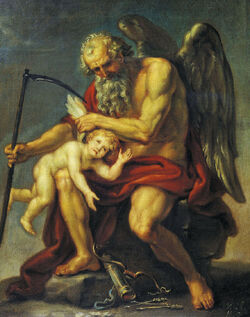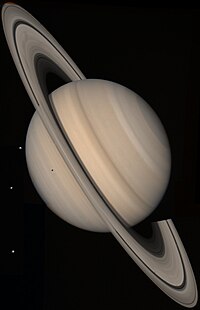- See also: Thor

1802 depiction of Saturn by Ivan Akimov.
In ancient Roman religion and myth, Saturn (Latin: Saturnus) was a major god presiding over agriculture and the harvest. His reign was depicted as a Golden Age of abundance and peace by many Roman authors. In medieval times he was known as the Roman god of agriculture, justice and strength. He held a sickle in his left hand and a bundle of wheat in his right. His mother was Terra and his father was Caelus. He was identified in classical antiquity with the Greek deity Cronus, and the mythologies of the two gods are commonly mixed.
Saturn's wife was Ops (the Roman equivalent of Rhea) and Saturn was the father of Ceres, Jupiter, Veritas, Pluto, Neptune, and Juno, among others. Saturn had a temple on the Forum Romanum which contained the Royal Treasury. Saturn is the namesake of both Saturn, the planet, and Saturday (dies Saturni).
Saturn is often identified with the Greek Cronus. In Hesiod's Theogony, a mythological account of the creation of the universe and Zeus' rise to power, Cronus is mentioned as the son of Uranus (the Greek equivalent of Roman Caelus), the heavens, and Gaia (the Greek equivalent of Terra), the earth. Hesiod is an early Greek poet and rhapsode, who presumably lived around 700 BCE. He writes that Cronus seizes power, castrating and overthrowing his father Uranus. However, it was foretold that one day a mighty son of Cronus would in turn overthrow him, and Cronus devoured all of his children when they were born to prevent this. Cronus's wife, Rhea (often identified with the Roman goddess Ops), hid her sixth child, Zeus, on the island of Crete, and offered Cronus a large stone wrapped in swaddling clothes in his place; Cronus promptly devoured it. Zeus later overthrew Cronus and the other Titans, becoming the new supreme ruler of the cosmos.
In the Roman tradition, in memory of the Golden Age of man, a mythical age when Saturn was said to have ruled, a great feast called Saturnalia was held during the winter months around the time of the winter solstice. It was originally only one day long, taking place on December 17, but later lasted one week. During Saturnalia, roles of master and slave were reversed, moral restrictions loosened, and the rules of etiquette ignored. It is thought that the festivals of Saturnalia and Lupercalia were the roots of the carnival year.
In mythology

16th century engraving of Saturn by Polidoro da Caravaggio.
According to Greco-Roman mythology, the first inhabitants of the world were the children of Terra (Mother Earth) and Caelus (Father Sky). These creatures were very large and manlike, but without human qualities. They were the qualities of Earthquake, Hurricane and Volcano living in a world where there was yet no life. There were only the irresistible forces of nature creating mountains and seas. They were unlike any life form known to man.
Three creatures born of Terra were monstrously huge with one hundred hands and fifty heads. Three others were individually called Cyclops, because each had only one enormous eye in the middle of their foreheads. Then, there were the Titans, seven of them, formidably large and none of whom were a purely destructive force. One was actually credited with saving man after creation.
Caelus hated the children with the fifty heads. As each was born, he imprisoned it under the earth. Terra was enraged by the treatment of her children by their father and begged the Cyclopes and the Titans to help her put an end to the cruel treatment. Only one Titan, Saturn, responded. Saturn lay in wait for his father and, depending on the source, either castrated him or sliced him into a thousand pieces with his sickle. From Caelus' blood sprang the Giants, a fourth race of monsters, and the Erinyes (the Furies), whose purpose was to punish wrongdoing. They were referred to as "those who walk in darkness" and were believed to have writhing snakes for hair and eyes that cried blood. Though eventually all the monsters were driven from Earth, the Erinyes are to remain until the world is free of sin.

16th century fresco by Paolo Veronese which depicts Saturn, as the personification of time, and Historia.

16th century engraving which depicts Saturn eating one of his children.
With the deposing of his father, Saturn became the ruler of the Universe for untold ages and he reigned with his sister, Ops, who also became his wife.
It was prophesied that one day Saturn would lose power when one of his children would depose him. To prevent this from happening, each time Ops delivered a child Saturn would immediately devour it. When her sixth child, Jupiter, was born, Ops had him spirited away to the island of Crete. She then wrapped a stone in his swaddling clothes. Her deception was complete when Saturn devoured it, thinking it was the child. When Jupiter was grown, he secured the job of cup-bearer to his father. With the help of Terra, his grandmother, Jupiter fed his father a potion that caused him to vomit up Jupiter's five immortal siblings, Vesta (Hestia), Ceres (Demeter), Juno (Hera), Pluto (Hades), and Neptune (Poseidon), who were still alive in their father's stomach.
A devastating war that nearly destroyed the Universe ensued between Saturn and his five brothers and Jupiter and his five brothers and sisters. Jupiter persuaded the fifty headed monsters to fight with him which enabled him to make use of their weapons of thunder, lightning and earthquake. He also convinced the Titan Prometheus, who was incredibly wise, and his brother, to join his side. With his forces, Jupiter was victorious and the Olympians reigned supreme. Saturn was, again depending on the source, either castrated or sliced into a thousand pieces with his own sickle (as he had done to his father) and cast into the darkest and deepest part of Tartarus, the underworld. His brothers were imprisoned in Tartarus as well except for Atlas, the strongest Titan, who was given the burden of holding up the sky.
In Roman mythology,[1] when Jupiter ascended the throne, Saturn fled to Rome and established the Golden Age, a time of perfect peace and harmony, which lasted as long as he reigned. In memory of the Golden Age, the Feast of Saturnalia was held every year in the winter at the winter solstice. During this time no war could be declared, slaves and masters ate at the same table, executions were postponed, and it was a season for giving gifts. This was a time of total abandon and merry making. It refreshed the idea of equality, of a time when all men were on the same level. When the festival ended, the tax collectors appeared and all money owed out to government, landlords, or lenders had to be accounted for.
Hesiod[2] wrote of the five ages of mankind: Gold, Silver, two ages of Bronze and an age of Iron. The Age of Gold was the purest age, when no labor was required and weather was always pleasant. It was virtually a place of pleasant surroundings and of abundance. Death was not an unpleasant eventuality and people occupied their time in pleasant pursuits.
Astrological beliefs

15th century depiction of Saturn watching over scholars.
Medieval and Renaissance scholars associated Saturn with one of the Four Temperaments of ancient medicine, melancholy. Physicians, scholars, philosophers and scientists, were rationalised to have a strong Saturn placement which gives them a tendency toward melancholy, but also wisdom.
Astrological Saturn has always been associated with the letter of the law. Gnostics have identified Saturn with the God of Early Scripture, whom they regarded as a tyrannical father, obsessed with rigid enforcement of the law. There is a symbolic link between Saturn and the God of Early Scripture through the use of Saturday. Saturn's Day, the seventh day of Scripture, the holy day of rest.
Saturn's function is contraction, which gives Saturn (called since ancient times "The Greater Malefic") a somewhat polarized role against Jupiter (called "The Greater Benefic") in astrology. In Vedic astrology Saturn and Jupiter are considered natural neutrals, but under closer relations become enemies (although William Lilly disagrees with this and considers them both friends). Similarly, Saturn is considered cold (slow) and dry (separate) whereas Jupiter is considered warm (speedy) and moist (inclusive). Where there is light Saturn brings darkness, where there is heat Saturn brings cold, where there is joy Saturn brings sadness, where there is life Saturn brings death, where there is luck Saturn brings misfortune (and sometimes heavy consequences for bad judgment or mistakes), where there is unity Saturn brings isolation, where there is knowledge Saturn brings fear, where there is hope Saturn brings skepticism and stalling. However these effects are not always negative. Saturn's properties of contraction and "crystallization" are said to create solidness in the world and give lasting form to everything physical and principle. Saturn is considered the only planet that doesn't cause over-expansion when negatively aspected with Jupiter, but rather causes Jupiter's expansion to remit.
Death, particular in old age, has been associated with Saturn since ancient times. At times the freedoms created by the other planets are abused so that remorse follows. Saturn's color is black. The element associated with Saturn is lead.
Saturn often stands for the father in the natal chart, as does the sun, however with Saturn it usually indicates problems with the father. Saturn indicates a tyrannical, domineering parent who seeks to mold his children in his own image and force them to live by his standards. Children often become "swallowed up" by such domination. Saturn's connection with agriculture suggests the nature of time. The Golden Years is a term used to describe the retirement years and Saturn rules old age.
Planet

Image of the planet Saturn compiled from images taken by Voyager 1 in 1981.
Saturn is a gas giant, the second largest planet in the solar system after Jupiter, and the sixth planet out from the sun. The planet is widely known for its prominently visible rings. Saturn is a sister planet to Jupiter, Uranus, and Neptune. Like most of the other planets in the solar system, Saturn is named after a Roman god. Just like with other planet's satellites, Saturn's moons are named after characters from Greek mythology.
In the ancient times, the planet Saturn was the farthest out of the five known planets other than Earth in the solar system (along with Mercury, Venus, Mars, and Jupiter; Uranus and Neptune had not yet been discovered), although the rings were not discovered until Galileo observed the planet in 1610.
References
Further reading
- Fellows, John. Mysteries of Freemasonry. ISBN 0217393489.
- Hamilton, Edith. Mythology. ISBN 9780316341516.
- Guirand, Felix (Editor); Aldington, Richard (Translator); Ames, Delano (Translator); & Graves, Robert (Introduction). New Larousse Encyclopedia of Mythology. ISBN 0517004046
- Guttman, Ariel & Johnson, Kenneth. Mythic Astrology: Archetypal Powers in the Horoscope. Llewellyn Publications.
- Parker, Julia & Derek. Parker's Astrology: The Definitive Guide to Using Astrology in Every Aspect of Your Life (New Edition). ISBN 078948014X .
- Woolfolk, Joanna Martine. The Only Astrology Book You Will Ever Need. ISBN 1589793773
External links
 Media related to Saturnus (deus) on Wikimedia Commons
Media related to Saturnus (deus) on Wikimedia Commons
| This page uses content from the English Wikipedia. The original article was at Saturn (mythology). The list of authors can be seen in the page history. |